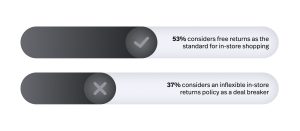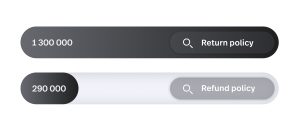
There is an issue in the retail world which is causing everybody involved a problem: returns.
And this isn’t an issue that is specific to either side. The businesses are suffering, the customers are too. So there has to be a solution that can appease both sides and allow commerce to keep on ticking with relative harmony, right?
Would that it were so simple.
In this piece, we’ll explore how the retail industry got to a point of such friction between businesses and consumers and (possibly) some resolutions that can save us all from certain doom.
Let’s get started.
- What are the stats on free returns?
- The cost of free returns for businesses
- Possible answers to the free returns questions
- The road ahead for businesses and customers
Want the inside scoop on what shoppers and retailers expect for 2024?
Download Lightspeed’s free Retail Insights & Shopper Sentiment for 2024 guide today.
What are the stats on free returns?
To gauge the level of impact returns have on the retail industry, let’s look at some of the stats surrounding them.
From Lightspeed’s 2024 Retail Report, we found that 53% of retail consumers think of free returns as the standard for in-store shopping, with 37% considering an inflexible in-store returns policy as a deal breaker.

And whilst offering free returns does feel like the norm at this point, it’s worth taking a look at how we got here.
Pre-COVID, free returns was seen as something of a differentiator—a dangling lure that could reel in potential customers with an added reason to shop with you, much the same as free shipping. Once COVID hit however, online shopping became more widespread as in-store shopping became a virtual impossibility and, in the spirit of good customer service in an online market, offering free returns made sense.
After all, if people are buying, for example, clothing in multiple sizes in order to try them on at home (in lieu of the usual in-store changing rooms), and sending back the ones that didn’t fit, the reasons are innocent enough and it was a practical way to keep the business afloat.
Obviously customers are all in on free returns. As consumers, they are after the most convenient shopping experience possible, and free returns is another step closer to that.
But these free returns have to cost somebody and that somebody is overwhelmingly the business.
The cost of free returns for businesses
Since the start of 2020, the refund and return pages of Australian e-commerce brands have seen a jaw-dropping 131% increase in visits.
And searches for return policies of Australia’s top e-commerce brands are leaving refund policy searches in the dust. In a span from April 2022 to March 2023, refund policy searches clocked in at 290,000. But returns? They pulled in a whopping 1.3 million searches.

The issue is ballooning and it’s not unreasonable to believe that such figures deserve attention and solutions.
The trouble is how.
The retail industry has been dealt an undeniably bad hand since the pandemic. Without the option of visiting a store in person, consumers were forced to shop entirely online, returns and all, and once the convenience factor took hold, the writing was on the wall.
And once something like free returns starts to become the norm, most of the industry’s hands become tied, forced to follow suit or risk losing out to those businesses that do.
Not even the most ambitious of thinkers could conceive of a scenario where customers would be the ones to fix the problem, voluntarily pushing to start paying for a service they’ve grown accustomed to getting for free. And so it falls, inevitably, on the businesses themselves to find a solution out of a problem they likely had no choice but to get into.
Possible answers to the free returns questions
There are already wheels in motion looking to tackle these issues, but the road on which they roll is one fraught with many potholes and hazards. The journey to an amicable resolution for both sides will not be a smooth one.
No more free returns
One such method is not offering free returns at all when returns are not made in-store, instead opting to charge the buyer a small fee to return their goods. The postage costs and some of the lost revenue can be recuperated by this fee, thus alleviating the financial burden for the business.
After all, the business upheld their end of the deal: they provided the goods that the customer chose. The customer is the one who wants to return them.
A free return window
Another means of dampening the financial blow is to limit the window in which customers can return goods. This keeps the goodwill and convenience that a free return garners, but goes some ways towards cutting down on the sheer amount of potential returns.
There are also customer loyalty programs that can offer free returns as a benefit to those deemed to have earned it. Whether via a spending threshold in purchases or limiting the amount of free returns a customer can make, this is an effective way to both offer free returns (to loyalty customers) and not offer them (to those not yet signed up).
AI-driven, custom returns policies for all
A final way which is more looking ahead rather than living in the here and now is utilising AI to fine tune these loyalty programs. With AI, customer loyalty allowances can be fine-tuned, each one bespoke to the individual customer.
Does a certain customer have a penchant for ordering multiple sizes of the same thing and sending back all but one? AI can limit their returns. Conversely, does another customer rarely return items, perhaps only for genuine issues such as defects? The free returns reins can be loosened.
Think of it as a reward for the customers who, with their higher spends and unreturned purchases, reward the business in turn, the less trustworthy customers are left to operate at arm’s length and under more restrictions.
Harnessing AI to create such a fluid returns policy is, it seems, a no-brainer, if the above can become a reality. It is something that would take humans far too much time and effort to manage, but something AI could manage and sustain without breaking a sweat.
The road ahead for businesses and customers
The discussion around free returns is a tangled mess, born from the best of intentions but now strangling businesses in a chokehold of costs and logistics. The pandemic threw fuel on this fire, transforming free returns from a perk into a baseline expectation. Now, we’ve got retailers haemorrhaging money, and consumers addicted to convenience.
How do we untangle this knot?
Do we scrap free returns for online purchases and charge a modest fee? It’s a bitter pill, sure, but one that might just save the patient. Or is it the creation of a return window—give customers a fair shot at sending things back, but not an indefinite free pass—that will prove out? Loyalty programs can add another layer: reward the faithful with free returns, while nudging the fickle to think twice.
And then there’s AI, a savvy digital concierge, customising return policies based on customer behaviour.
The road to solving this mess isn’t smooth. It’s a patchwork of solutions, a blend of tough love and forward thinking. But with some grit and a little innovation, retailers can navigate such treacherous terrain, striking a balance between staying afloat and keeping customers happy. It’s not about finding a silver bullet—it never was. It’s about who flinches first when the dollars leaving their pockets hits the tipping point.

News you care about. Tips you can use.
Everything your business needs to grow, delivered straight to your inbox.


